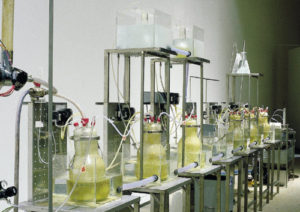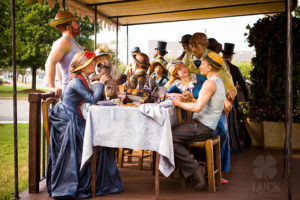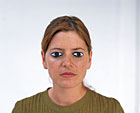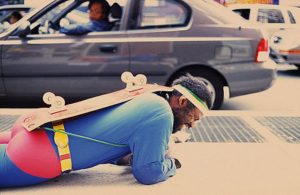Cloaca
I always thought that one of the advantages of machines over humans is that machines don’t have all those biological needs. The robots that assemble cars don’t sleep, eat, or go to the bathroom.
Which is why, I suppose, there are no big corporations sponsoring “Cloaca” at the New Museum of Contemporary Art in Manhattan. “Cloaca” is the first machine ever designed that eats, digests, and eliminates. It has, of course, no practical value. It is the creation of a Belgian artist named Wim Delvoye, who put it together with the help of scientists from the University of Antwerp and then found a surprising number of critics and theorists to comment on it.

“Cloaca” looks like an elaborate medical apparatus, with lots of tubes and a series of large glass containers. The name means sewer, and also refers, in biology, to an excretory duct or cavity found in birds, reptiles, and other animals.
Every afternoon at about 4:30 a museum attendant climbs a metal staircase and throws some food into a large plastic funnel that serves as the apparatus’s mouth. There it is chewed up by a garbage disposal and a meat grinder. Then it begins a 22-hour passage through six glass chambers containing enzymes, bacteria, bile, and other digestive juices. As it is pumped from chamber to chamber and mechanically stirred, the liquified food becomes progressively darker. Finally, it goes into a metal box that extracts the liquids and, at 2:30 p.m. every day, museum visitors can see the remaining solids extruded onto a green conveyor belt.
Contrary to a popular saying, s—- doesn’t just happen.
It struck me as the sort of thing a perverse, ingenious high school student might do for a science project. Were it a science project, however, more attention would probably be paid to the extraction of the nutrients from the food and how they go into building and fueling the body. Here, the roles are somewhat reversed. The nutrients are discretely siphoned off and disposed of as if they didn’t really exist, while the waste is presented as the end product.
What could it mean? Freud had a lot to say about people who remained preoccupied with excretory functions, a stage that all children pass through. But Delvoye is also an artist who likes playing with his food: He makes elaborate mosaic floors out of neatly cut pieces of ham and salami. And, like every teenager, he has popped a zit or two and, in big, blown-up images, explores the eternal question – just what is that stuff that comes out?
Delvoye, then, is that familiar figure in the contemporary art world – the bad boy. He is the art-world equivalent of Tom Green eating a handful of mealworms.
Bad art gives off an effluvium of critical theory, and for those who need to feel that a defecating machine has intellectual significance, the catalog should prove handy. In the early throes of postmodernism, we are told, we dwelt in what the critic Neville Wakefield called “the twilight of the real.” God had died, history was at an end, and there was nothing left to doubt except reality itself.
But this got tiresome, according to critic Dieter Roelstraete. Artists, always quick to flip an idea, decided to resurrect the real. You want real? We’ll give you real, they seemed to say, and seized on the physical body as something that was undeniably real. Body fluids were particularly favored. So there were jars of urine, and drawings made from blood, and evocations of semen and breast milk. Dead bodies were popular subjects. The so-called Formaldehyde School of photography photographed jars of specimens and body parts, and museum visitors found themselves face to face with bisected cows.
Humans have a strong aversion to feces, however, and this did not become a popular art material, although Chris Ofili got a lot of attention with his elephant dung.
But a machine that poops – well, that’s not actually the real thing, and so Delvoye seems to have gotten around the problem. And the New Museum has gotten around the problem of odor by enclosing the final stage of the process in a sealed chamber that vents into a back alley.
Then there’s a whole other take on “Cloaca,” as a satiric comment on the quest for artificial intelligence, which really isn’t bad, but the theorists tend to get a little carried away here —with windy reflections on Marcel Duchamp, the mystery of consciousness, and the meaning and purpose of art—and hence ruin what might be a perfectly good joke.
The exhibit has its moments. The guard on duty the day I was there had a funny story to tell about some of “Cloaca’s” feeding problems. It seems they started out giving it fancy food from Soho restaurants – eggs Benedict, salmon mousse, that sort of thing. But the rich diet gave it diarrhea. “And you know,” said the guard, “I ate the food from that same restaurant and I got sick, too.”
Thumbing through the catalog, there was a previous work by Delvoye that I also found amusing: his tattooed pigs. The artist (or more likely a tattoo artist) decorated the pink backs and flanks of the animals with an array of biker-type tattoos: Harley-Davidson logos, grinning skulls, flaming devils, and hearts with knives thrust into them. The brawny pigs, wallowing about in the yard and seeming to leer at us, look the part, actually. And you can almost imagine one saying to the other: “I got drunk. Woke up like this. Can’t remember a thing.”
New Museum of Contemporary Art
2002






